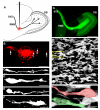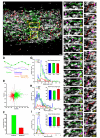Dynamic imaging reveals that brain-derived neurotrophic factor can independently regulate motility and direction of neuroblasts within the rostral migratory stream
- PMID: 20538046
- PMCID: PMC2935908
- DOI: 10.1016/j.neuroscience.2010.05.075
Dynamic imaging reveals that brain-derived neurotrophic factor can independently regulate motility and direction of neuroblasts within the rostral migratory stream
Abstract
Neuronal precursors generated in the subventricular zone (SVZ) migrate through the rostral migratory stream (RMS) to the olfactory bulb (OB). Although, the mechanisms regulating this migration remain largely unknown. Studies have shown that molecular factors, such as brain-derived neurotrophic factor (BDNF) emanating from the OB, may function as chemoattractants drawing neuroblasts toward their target. To better understand the role of BDNF in RMS migration, we used an acute slice preparation from early postnatal mice to track the tangential migration of GAD65-GFP labeled RMS neuroblasts with confocal time-lapse imaging. By quantifying the cell dynamics using specific directional and motility criteria, our results showed that removal of the OB did not alter the overall directional trajectory of neuroblasts, but did reduce their motility. This suggested that additional guidance factors present locally within the RMS region also contribute to this migration. Here we report that BDNF and its high affinity receptor, tyrosine kinase receptor type 2 (TrkB), are indeed heterogeneously expressed within the RMS at postnatal day 7. By altering BDNF levels within the entire pathway, we showed that reduced BDNF signaling changes both neuroblast motility and direction, while increased BDNF levels changes only motility. Together these data reveal that during this early postnatal period BDNF plays a complex role in regulating both the motility and direction of RMS flow, and that BDNF comes from sources within the RMS itself, as well as from the olfactory bulb.
Published by Elsevier Ltd.
Figures






Similar articles
-
Regional effects of endocannabinoid, BDNF and FGF receptor signalling on neuroblast motility and guidance along the rostral migratory stream.Mol Cell Neurosci. 2015 Jan;64:32-43. doi: 10.1016/j.mcn.2014.12.001. Epub 2014 Dec 3. Mol Cell Neurosci. 2015. PMID: 25481343 Free PMC article.
-
Relationship between Blood Vessels and Migration of Neuroblasts in the Olfactory Neurogenic Region of the Rodent Brain.Int J Mol Sci. 2021 Oct 25;22(21):11506. doi: 10.3390/ijms222111506. Int J Mol Sci. 2021. PMID: 34768936 Free PMC article. Review.
-
Brain-derived neurotrophic factor promotes vasculature-associated migration of neuronal precursors toward the ischemic striatum.PLoS One. 2013;8(1):e55039. doi: 10.1371/journal.pone.0055039. Epub 2013 Jan 29. PLoS One. 2013. PMID: 23383048 Free PMC article.
-
EphA4 Regulates Neuroblast and Astrocyte Organization in a Neurogenic Niche.J Neurosci. 2017 Mar 22;37(12):3331-3341. doi: 10.1523/JNEUROSCI.3738-16.2017. Epub 2017 Mar 3. J Neurosci. 2017. PMID: 28258169 Free PMC article.
-
Dynamic changes in the transcriptional profile of subventricular zone-derived postnatally born neuroblasts.Mech Dev. 2013 Jun-Aug;130(6-8):424-32. doi: 10.1016/j.mod.2012.11.003. Epub 2012 Dec 5. Mech Dev. 2013. PMID: 23220001 Review.
Cited by
-
Distribution of CaMKIIα expression in the brain in vivo, studied by CaMKIIα-GFP mice.Brain Res. 2013 Jun 26;1518:9-25. doi: 10.1016/j.brainres.2013.04.042. Epub 2013 Apr 28. Brain Res. 2013. PMID: 23632380 Free PMC article.
-
Drug treatments that optimize endogenous neurogenesis as a therapeutic option for stroke.Brain Circ. 2017 Jul-Sep;3(3):152-155. doi: 10.4103/bc.bc_20_17. Epub 2017 Oct 12. Brain Circ. 2017. PMID: 30276317 Free PMC article. Review.
-
Improving Neurorepair in Stroke Brain Through Endogenous Neurogenesis-Enhancing Drugs.Cell Transplant. 2017 Sep;26(9):1596-1600. doi: 10.1177/0963689717721230. Cell Transplant. 2017. PMID: 29113469 Free PMC article. Review.
-
Regional effects of endocannabinoid, BDNF and FGF receptor signalling on neuroblast motility and guidance along the rostral migratory stream.Mol Cell Neurosci. 2015 Jan;64:32-43. doi: 10.1016/j.mcn.2014.12.001. Epub 2014 Dec 3. Mol Cell Neurosci. 2015. PMID: 25481343 Free PMC article.
-
Fascin regulates the migration of subventricular zone-derived neuroblasts in the postnatal brain.J Neurosci. 2013 Jul 24;33(30):12171-85. doi: 10.1523/JNEUROSCI.0653-13.2013. J Neurosci. 2013. PMID: 23884926 Free PMC article.
References
-
- Altman J. Autoradiographic and histological studies of postnatal neurogenesis. IV. Cell proliferation and migration in the anterior forebrain, with special reference to persisting neurogenesis in the olfactory bulb. J Comp Neurol. 1969;137:433–457. - PubMed
-
- Anton ES, Ghashghaei HT, Weber JL, McCann C, Fischer TM, Cheung ID, Gassmann M, Messing A, Klein R, Schwab MH, Lloyd KC, Lai C. Receptor tyrosine kinase ErbB4 modulates neuroblast migration and placement in the adult forebrain. Nat Neurosci. 2004;7:1319–1328. - PubMed
-
- Bath KG, Mandairon N, Jing D, Rajagopal R, Kapoor R, Chen ZY, Khan T, Proenca CC, Kraemer R, Cleland TA, Hempstead BL, Chao MV, Lee FS. Variant brain-derived neurotrophic factor (Val66Met) alters adult olfactory bulb neurogenesis and spontaneous olfactory discrimination. J Neurosci. 2008;28:2383–2393. - PMC - PubMed
-
- Bovetti S, Bovolin P, Perroteau I, Puche AC. Subventricular zone-derived neuroblast migration to the olfactory bulb is modulated by matrix remodelling. Eur J Neurosci. 2007;25:2021–2033. - PubMed
Publication types
MeSH terms
Substances
Grants and funding
LinkOut - more resources
Full Text Sources
Miscellaneous

